The Ultimate Guide to B2B Content Marketing Strategy in 2022
“It’s hard to create truly engaging content for a B2B business .”
Have you ever heard this statement? It’s a common opinion that B2B content can be pretty dry. And why would you need it at all? You can rely on your trusty connections who could get you new clients through word-of-mouth.
In reality, more often than not, a B2B company’s success is attributed to content marketing rather than following someone else’s recommendations. The reason is simple – what works for one company might not work for another, and content helps make a good first impression on a prospect when learning about a product.
Without a doubt, building a B2B content marketing strategy is a trial-and-error process. Today, we want to help you make fewer mistakes and share a step-by-step guide on building a B2B content strategy, along with a few inspiring examples.
What is B2B Content Marketing
Before we jump over to the practical part, let’s clear up the B2B content marketing definition and how it is different from B2C content marketing.
Business to business (B2B) content marketing is a strategy of creating and sharing the content to improve traffic, generate leads, boost sales, or raise brand awareness. This strategy involves the following types of B2B marketing:
- blogging
- white papers
- research
- polls and surveys
- social media
- email marketing
- video marketing
Ideally, compelling content for a B2B marketing strategy should be targeted, contextually relevant, and deliver value.
What’s the difference between B2B and B2C content marketing?
The key difference would be in the audience these strategies target. For B2B, content marketers focus on the audience that mostly consists of a business’s decision-makers.
Besides, B2B content aims to engage the target audience persona and build a relationship, while B2C content focuses on speeding up the conversion and sales process.
Why B2B Companies Need Content Marketing
You might feel reluctant to invest in various B2B content marketing strategies, especially if your business heavily relies on word-of-mouth and you find your clients through your existing partners.
But whatever your customer acquisition strategy is, there are a few reasons why you can’t say no to content marketing. Let’s take a look at them.
1) Great Return on Investment
It might seem that developing a content strategy will cost you a pretty penny. Indeed, some content types, like video, may be expensive to produce. But if your B2B strategy is solid, your investment will pay off.
In general, each B2B marketing strategy will have a different average ROI. For example, email marketing can have an ROI of 122%. The actual percentage will depend on your content marketing goals. But if you plan your strategy correctly, it definitely won’t be a waste of money.
2) Strong Authority in Your Industry
People usually research a brand before purchasing a product, and B2B buyers are not an exception. According to Gartner’s study, B2B buyers spend 27% of their time researching a product online and 18% studying it offline.
By investing in a B2B content marketing strategy, B2B marketers create channels to educate potential customers. Besides, the content you produce for your buyers also levels up your authority in the industry.
3) More Brand Exposure
As we already mentioned, B2B companies usually do content marketing to raise brand awareness. According to Content Marketing Institute, 50% of all B2B content in 2020 was created to promote a brand.
Content is the tool that helps your company stand out. If you do it right, the content will differentiate you from your competitors, benefiting your brand’s exposure.
How to Develop an Effective B2B Content Strategy Plan
The theory is covered, so let’s move on to the practical part and discuss how to create a content strategy and build that solid B2B content strategy plan.
1. Identify your target audience
In marketing, it’s a rule set in stone—without a well-defined buyer persona, producing content is a waste of time. You need to know whom you’re selling your product and which needs you’re catering to.
So, start planning your B2B content marketing plan by defining your audience. First of all, you need to research the basics:
- Demographics—age, gender, language, location, marital status, job, income.
- Psychographics—needs interests, hobbies, challenges.
With these metrics, you will create a decent target audience persona. But to create a more precise one, you need to take advantage of previously collected data about your customers, such as:
- purchase behaviors
- buying intent
- abandoned carts
- customer service tickets
- search queries people use to find your brand
Additionally, you can browse through data on social media platforms (known as social data) to add specific details to your buyer persona. For example, on LinkedIn, you can find the information on your followers’ job functions:
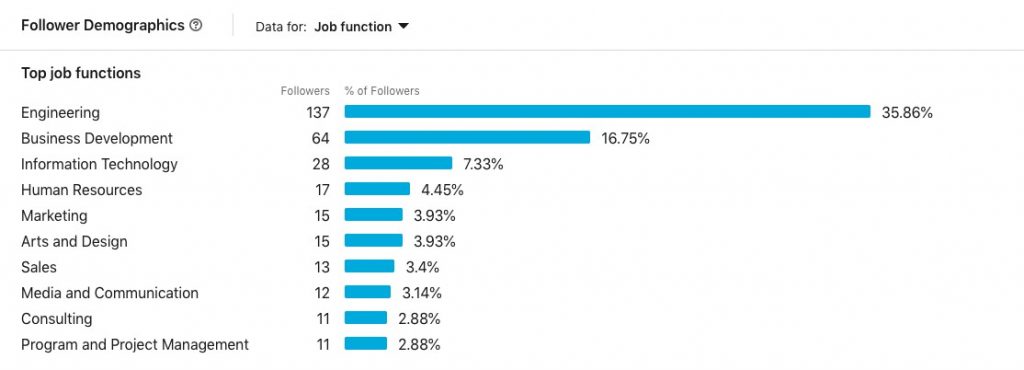
Also, some social listening can supply you with recent updates on your potential buyers. You can hold some surveys to research your audience deeper and determine their demographics, needs, and content preferences.
At this point, you should also consider the B2B content marketing funnel and how your content fits in every stage of the customer journey.
The simplest B2B sales funnel includes the following stages:
- awareness
- consideration
- preference
- purchase
- loyalty
Your task is to figure out which of these stages you want to target with your content. Once you have a clear understanding of your sales funnel, you can move forward to setting goals, KPIs and defining the metrics and benchmarks to measure your successes later on.
2. Brainstorm content topic ideas
The next step is content ideation, or finding the most relevant topics to engage your target buyers. There are a few ways to find content marketing topics.
First, you can do extensive keyword research with these three steps:
- Make a list of all keywords relevant to your brand and product. Consider your industry, the needs that your product covers, and come up with a general list of keywords.
- Extend the list with keyword variations. To find them, you can check the People Also Ask and Related Search sections in SERPs and aim at long-tail keywords. You can also use the help of keyword search tools. Here, you can see how SEMrush generates different variations of content marketing keywords:
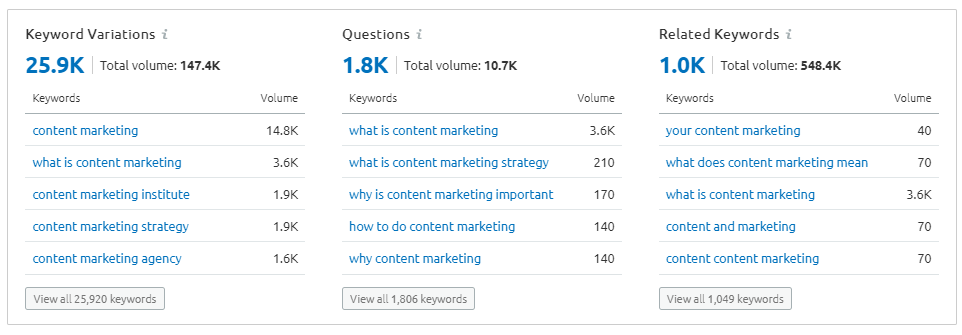
- Think about the intent of each keyword. Does a keyword serve informational, navigational, transactional, or commercial investigation purposes? Break down your keywords according to the types of search intent to see which stage of the sales funnel they will fit in.
Keyword research will come in handy to help you find high-volume keywords and create content pillars. Then, you can move towards more long-tail keywords to create topic clusters around the central pillar page. As a result, you have a new content strategy ready.
Next, you can employ a few online tools to help you search for B2B content marketing ideas. For instance, you can start with BuzzSumo – just type in a keyword and browse through the list of related topics:
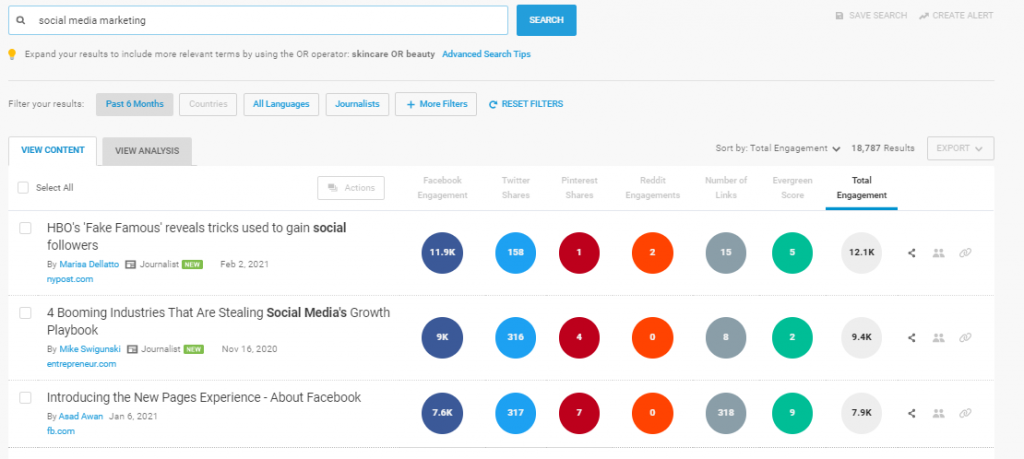
The perk of using BuzzSumo is that you can also track trending topics related to a specific keyword and take advantage of them to increase engagement.
Another resource to help you find the hottest topics is Google Trends. Just type in the keyword to see how the interest around it has been changing over time:
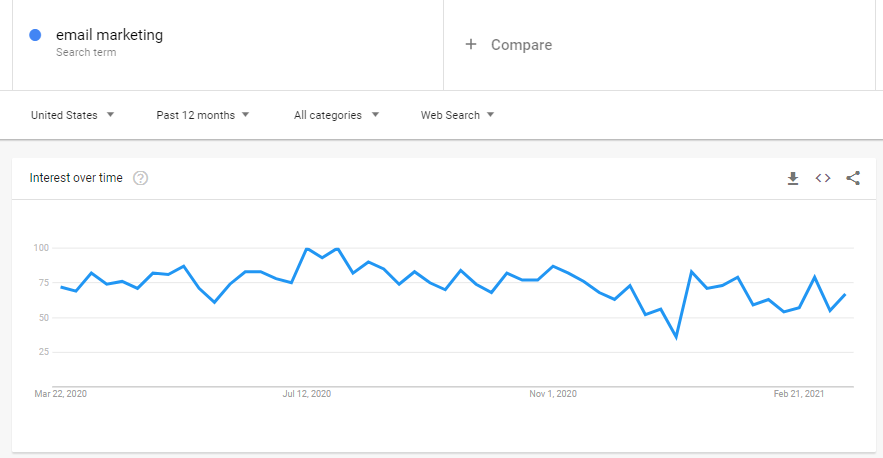
You can also take advantage of Google Trends to extend your list of keywords with related topics and queries:
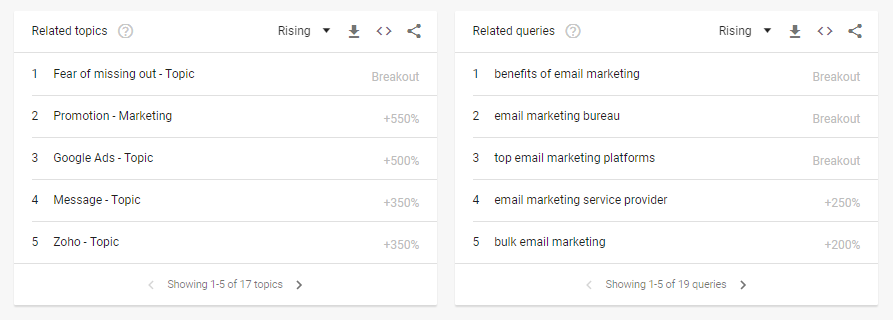
One more tool you can use to find relevant content ideas is Answer the Public. All you need is to enter a keyword, and the tool will generate a mind map with related long-tail keywords:

Answer the Public is often used to build keyword lists, but it can be beneficial when making a content map.
3. Put together a content plan
The next step in developing a content strategy is organizing all your previous research into a cohesive plan.
Start by choosing a content distribution channel:
- Owned – the content distribution channels that belong to your business.
- Shared – social media platforms and other channels, where you can upload content but have to comply with the policies.
- Paid – third-party platforms including native, search, and social media ads.
Your choice of the distribution channels should be based on your target audience’s content needs and the sales funnel stage.
Then you can move forward to selecting the content types. Depending on your buyer persona and the stage of the buyer’s journey, you can focus on crafting written, video, audio, visual, or social content types. Your choice will also depend on the types of content at the top of SERPs related to a specific keyword.
Once the distribution channels and types of content have been taken care of, you can start designing a content calendar – a publishing schedule. A thorough content calendar should contain:
- publishing dates
- distribution channels
- categories or campaign names
- topics
- main topic-related keywords
- additional resources
You can create such a calendar using Google Sheets or Google Calendar. If your website is using WordPress, you can also take advantage of editorial plugins.
4. Write, publish, distribute, update
When you have your content plan and keyword list at hand, it’s time to write your content. But before you publish your content, make sure it possesses the five key characteristics of engaging B2B content:
- value
- relevancy
- credibility
- shareability
- use of visual support
Should B2B content be entertaining? Absolutely. You still can involve memes and other means of visualization to lure your audience to continue reading. The key point here is to keep these hooks relevant to the context and not let them overshadow the content’s main idea.
If you are sure your content has all the necessary qualities to serve its purpose, you can publish and distribute it. But at this point, building a content strategy is not over.
Once your content is up, you need to keep monitoring its performance. It’s normal if you find out your content is lagging behind in some ways. Your task is to find the issues that cause this mal performance, fix them, and update your content to ensure it reaches the goals you’ve set for it.
7 Foolproof B2B Content Marketing Strategies
So now, as we’ve learned how to develop a content marketing strategy in general, let’s take a look at the seven most common B2B content marketing strategies, along with some examples.
1. Publish original research and studies
The fastest and most efficient way to build authority and recognition in any industry is by investing in original, in-depth research or a case study. B2B companies regularly invest in various studies for their blogs and sometimes involve them in massive content marketing campaigns.
High-quality B2B research should possess the following characteristics:
- focus on pressing topics in a given industry
- follow a systematic structure
- provide evidence that supports the main idea
- share unique insights
- offer a practical solution
- inspire further action
You can see all of these qualities being embodied in Tidio’s study on the Ideal Customer Experience in 2021, exploring the current shopping trends through the consumers’ eyes.
Tidio’s study is based on an original survey of 1,004 shoppers and compares this survey results to other related stats and the latest trends in commerce. As a result, the readers get an objective look at the problem of the customer journey.
A couple of things you can take inspiration from this study are the list of additional resources and the study’s methodology. These two components are usually optional, but you can use them to invite the reader to look deeper into the study’s subject. Besides, they make your research look more authoritative.
2. Experiment with LinkedIn posts and articles
Contrary to a faulty belief, B2B companies can build engaging social media strategies, especially on LinkedIn, which exists for that purpose – businesses name it the number one platform for B2B marketing, followed by Twitter.
LinkedIn is not just about re-sharing your blog posts along with some short captions. This platform allows different types of posts to drive engagement, and companies like Templafy are a great example of how you can take advantage of that.
On Templafy’s LinkedIn page, you can find videos, guides, polls, and even presentations:
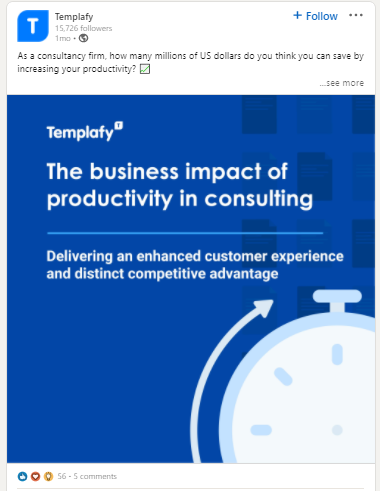
What also makes Templafy an excellent example of content marketing for B2B is that it doesn’t focus its LinkedIn strategy just on product-related posts.
On Templafy’s LinkedIn page, you can also come across short interviews with employees in which they share their experience and perspective. This approach helps Templafy build a positive online image of the company, impacting its relationships with potential buyers.
3. Invest in video marketing
Today, it’s hard to imagine any marketing strategy without video content. And why not invest in videos if they have such a stellar ROI – 78% of marketers say videos directly helped them increase sales.
The beauty of creating videos is that it has become accessible to businesses of any size. You don’t have to bring the entire production crew to make a good video, which is good news for small companies, startups, and personal brands.
For instance, take a look at Ron Stefanski, a digital marketing specialist. He has a YouTube channel called One Hour Professor, where he uploads videos on online advertising, B2B content marketing tips, as well as the interviews with other digital marketers:
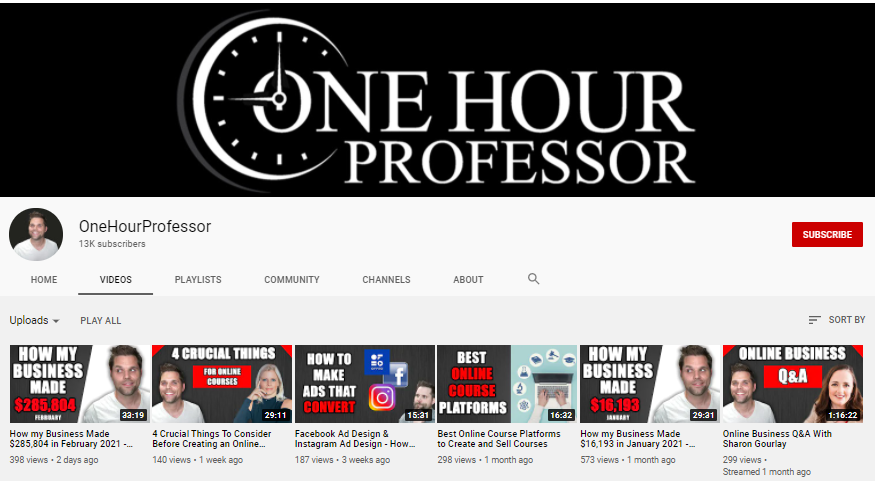
The format of the videos, which Ron creates for his channel, only requires basic video editing and Photoshop skills to create thumbnails. As you can see, it’s possible to create video content with minimal investment, and it will still help attract attention to your brand.
4. Build product or service landing pages
Landing pages are among the best practices in B2B content marketing, and for a good reason – they are in the middle of the sales funnel and serve an essential purpose of converting leads into customers.
Of course, all landing pages aren’t born equal. To make sure you don’t mess up yours, consider these characteristic features of effective landing pages before creating one:
- A proper structure. Organize the flow of the information that leads to a call-to-action without making it too pushy.
- A need-oriented headline. Craft landing page titles in a way that addresses a particular need of your target audience. If your product offers multiple solutions, it’s better to create separate landing pages for each of them.
- Evidentiary support. A good landing page always contains testimonials and customer reviews to prove your points and make your claims sound legitimate.
The perfect embodiment of all three characteristic features is LiveChat’s landing page for different industries. This landing page contains several clickable subsections, which a customer can follow to see how LiveChat’s product can solve issues particular to their industry:
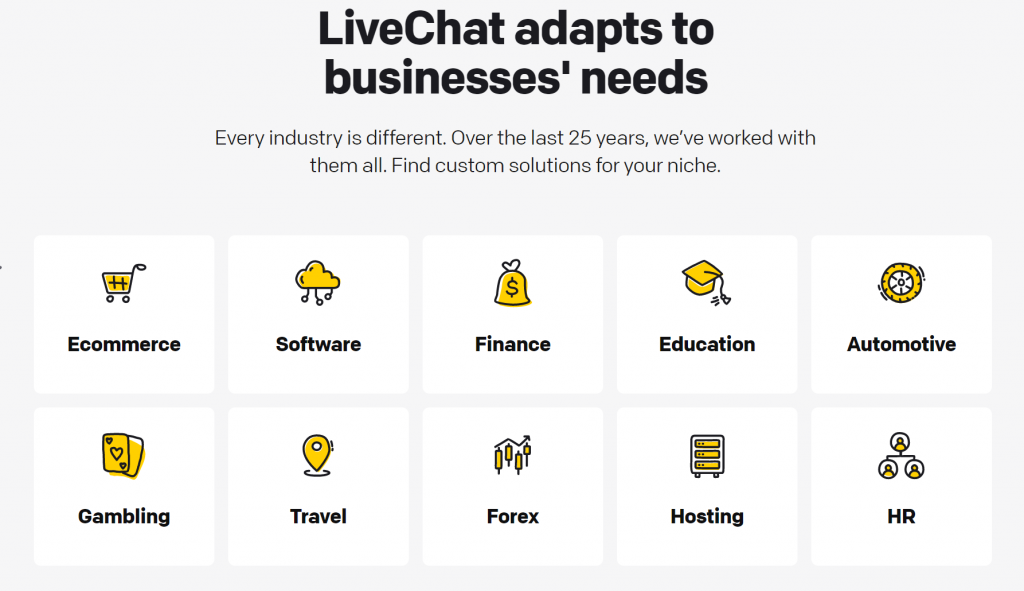
Each subpage addresses industry-related needs and shares testimonials from LiveChat’s customers that have used its product and can confirm the results.
5. Create an email course or newsletter
Another typical B2B content strategy example is email marketing. B2B companies use emails to target and nurture leads by sharing an exclusive piece of content such as newsletters.
However, you can go further with your email marketing strategy and create an entire email course to attract potential leads.
An email course is a set of lectures you deliver via email within a specific timeframe. Once this course ends, you can issue a certificate for each participant.
A fantastic example is Surfer’s SEO for Copywriters email course. It’s a seven-day event available to anyone upon subscription. Each day is dedicated to a certain topic with an end goal to improve a participant’s value as a content writer:
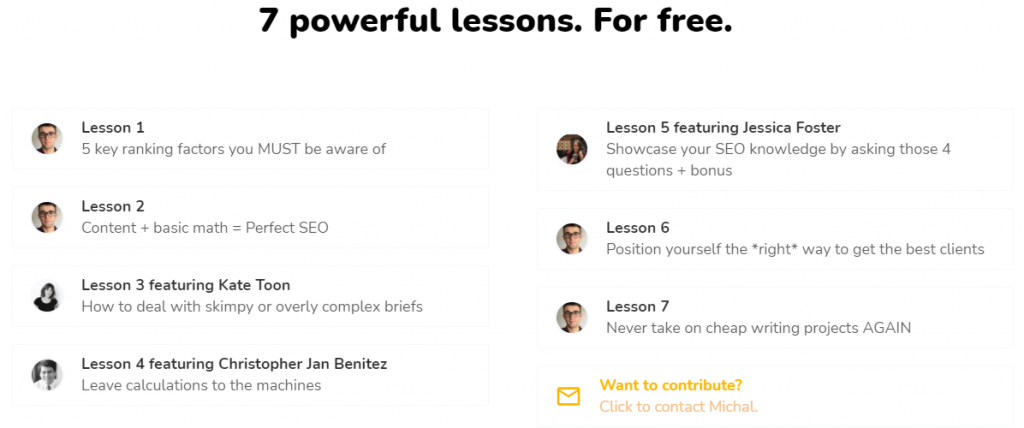
An email course is also a great opportunity to introduce your product and prove its value to a customer. Each lesson can contain a practical part, in which you can involve your product to show how it works and what it can do. It’s a great way to sell your product without being pushy.
6. Write how-to guides for a blog
You now know that research and studies can enrich your blog, but the truth is that they won’t appear there often – research can be very time-consuming. Besides, too much research can make your blog come off overly academic.
Regularly, you can write how-to guides, which have similar value to studies and research but don’t take as much time. Such content is typical in content-based marketing since it’s the fastest route to building authority in your industry.
A great example of how publishing guides can raise brand awareness is HubSpot. Its blog is filled with various how-to guides on different digital marketing topics:

HubSpot’s guides are known for being actionable and evidence-based, which sets a good example for all other B2B companies to follow. Besides, HubSpot often uses its guides to educate the readers about its products and the needs they can solve.
7. Invest in webinars or a podcast
One more B2B content marketing strategy idea is a webinar. Much like an email course, a webinar is usually available only to the subscribers and usually focuses on one product’s practical applications.
SEMRush often runs webinars that involve product promotion. For instance, the webinar below shares how businesses can use SEMrush’s solution to engage and personalize their audience:

Another excellent content format you can add to your B2B marketing strategy is a podcast, especially if your goal is to educate your audience – three out of four podcast listeners engage in podcasts to learn something new.
Podcasts are versatile in that you can tailor them to any topic or industry. For instance, OmniConvert’s podcast shares e-commerce growth stories to inspire their listeners, who run primarily online businesses. You’ll also find helpful e-commerce marketing tips there too.
Best B2B Content Marketing Campaigns Examples
Now you know that content creation is a must for your brand, and you’ve seen enough successful B2B content marketing examples to prove that.
Now, let’s scale up a bit and conclude our articles with a few examples of successful B2B content marketing campaigns and their strategies to achieve the goals.
1. Social Insider – Original research and studies
As we mentioned above, B2B companies can invest in research and studies to enrich their content marketing strategies and build authority in the industry. The research should be 100% original and offer unique insights.
However, it doesn’t mean that you should conduct research all by yourself. As you know, it takes some time to find, organize, analyze, and compile data into a study. A great solution is to partner with another company and turn your collaboration into a campaign.
A great example of such a partnership is Social Insider and Wave.Video’s joint study of over 700K Instagram Stories and story ads to find strategies that deliver the best results.
The findings of this study are unique. For example, it shows that brands post up to 8 stories per day on average, but five stories are enough to maintain the high retention rate.
What benefits did this collaboration give to Social Insider and Wave.Video?
This joint study touches upon the burning topic. The results of this study give consistent advice to all the brands who actively use Instagram on how to get the most out of Stories format based on real evidence and statistics. Plus, you can’t deny how helpful this study is for both companies’ authority in their respective niches.
2. Venngage – Sharing free templates in blog posts
Sometimes B2B companies are building a content strategy for lead generation. Venngage turned such a strategy into an entire B2B marketing campaign to promote its online template editors.
The campaign’s idea is simple – Venngage created a blog post with a list of 10 infographics templates for beginners with a short description for each template. Under every description, there’s a CTA button that redirects the reader to a landing page with a respective template:
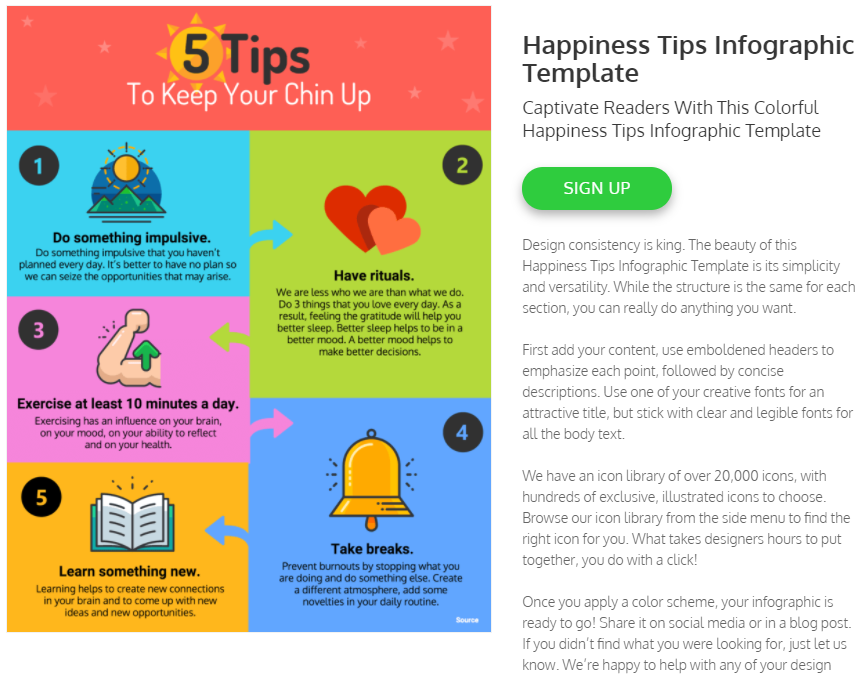
And here’s the interesting part – to get access to the template editor, the reader needs to sign up first. As a result, you get your free template, and Venngage gets one more lead to turn into a customer.
You might be wondering – why create an entire blog post for the list of templates that people can easily find on Venngage’s homepage?
Most likely, when looking for infographic templates, the searchers don’t know that Venngage offers them. What they know is they need a template. Besides, this blog post provides infographic templates of the particular (beginner) level, and searchers can compare the proposed templates right away without having to click on each one separately.
3. Digital Olympus – Increasing brand awareness through LinkedIn
You already know that B2B content marketing is not just about blog posts. A B2B content marketing strategy involves social media content as well that companies often use to raise brand awareness.
A fantastic example of a smart content strategy on social media is Digital Olympus’s activity on LinkedIn. What’s great about this strategy is that the brand’s CEO Alexandra Tachalova often shares posts from her company’s LinkedIn profile, adding her personal take on what the post is about:
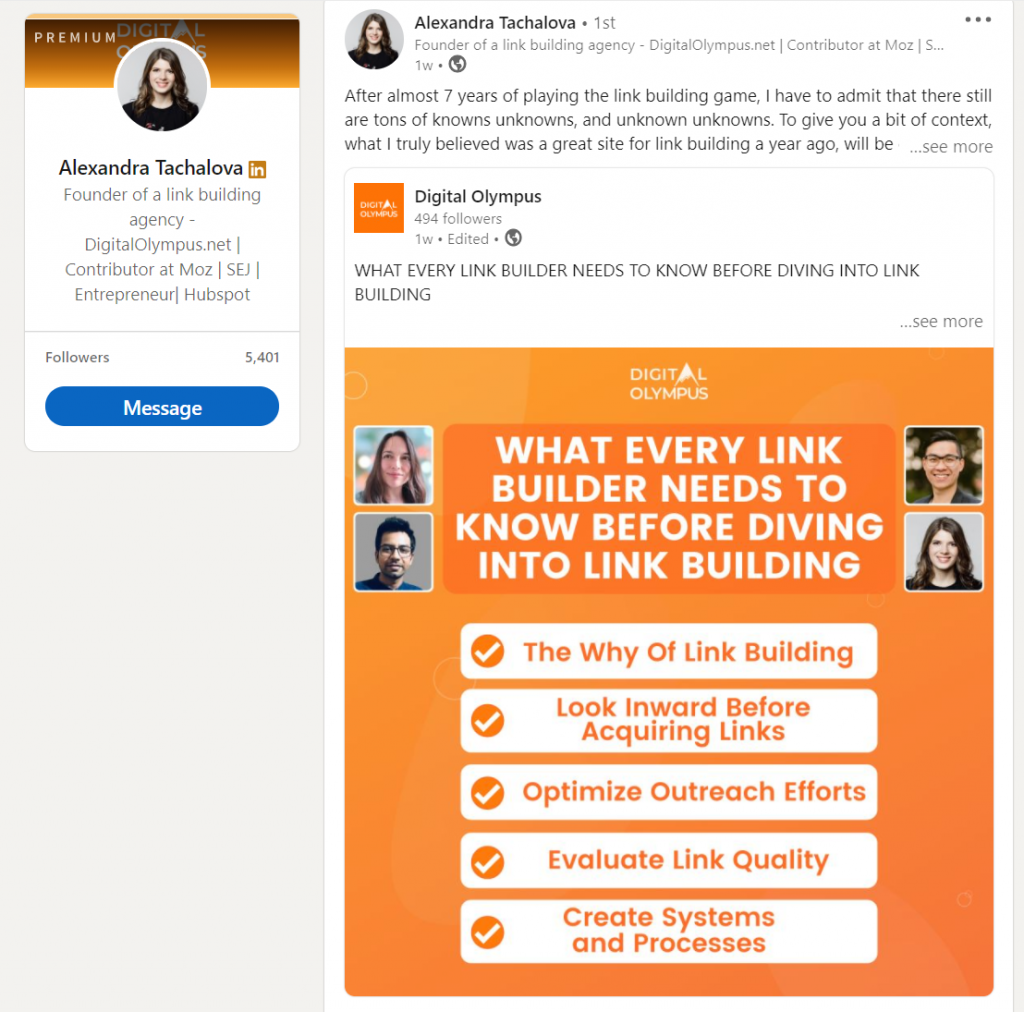
Such an approach kills two birds with one stone – it not only increases the activity on Digital Olympus’s LinkedIn page but also contributes to its CEO’s personal branding and improves her authority in the link building niche.
4. Cisco – Leveraging the power of video marketing
You can spread brand awareness and generate leads by adding videos to your B2B strategy.
As you already know, you don’t have to hire a production crew right away to produce high-quality videos. The main goal is to create video content that is helpful and answers your audience’s particular needs.
Take a look at Cisco’s YouTube channel, for example. This B2B brand has a rich video marketing strategy, with interviews, product announcements, and industry updates. But the videos that stand out touch upon operating Cisco’s product and its features:

The goal of Cisco’s video strategy is to educate. That’s why on its YouTube channel, you will find videos telling about the company’s product and its impact on the telecommunications industry. As a result, Cisco’s video marketing strategy creates a cohesive and authoritative image of the brand.
B2B Content Marketing Topic Recap
There’s no point in denying it:B2B companies with solid content marketing strategies are bound to succeed – strategies and campaigns we analyzed in this article confirm this statement.
But much like with any other content strategy, B2B content has to have a clear purpose, serve a specific need of a particular target audience, be original, offer unique insights, and appear on the right channel to reach the right customers.
Sounds tough, and indeed – creating a solid B2B content marketing strategy is a lot of pressure. But are your choices regarding strategy options limited? No, and on the contrary – you can adjust any content type to fit your needs. The only thing you should keep in mind is that your content should be purpose-driven and have a clear goal.




